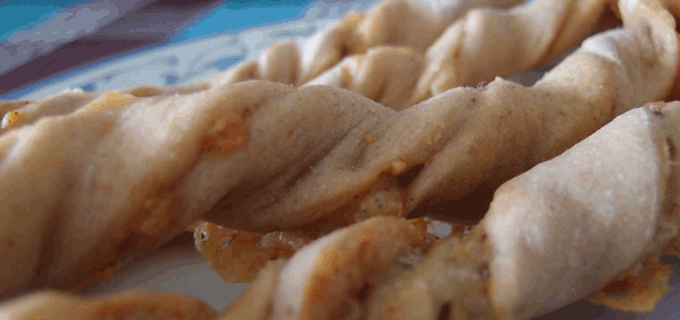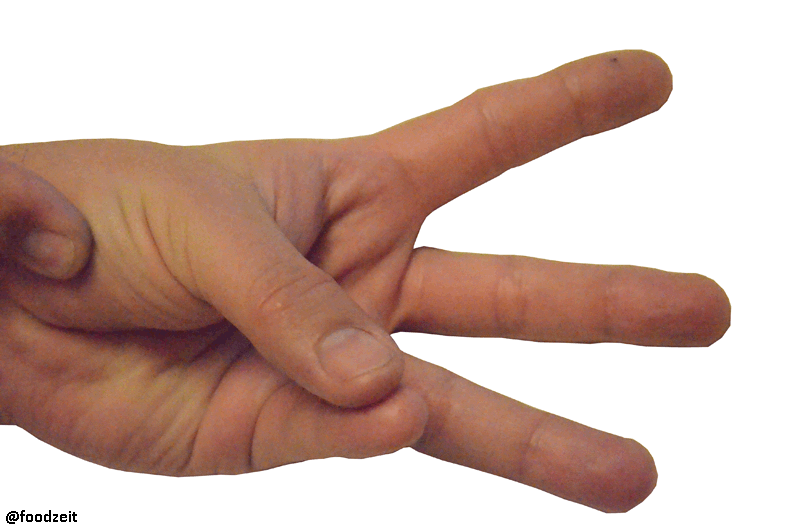Hühnchen Fleisch braucht nicht sehr lange zum garen, darum passiert es immer wieder dass das Fleisch zu lange gekocht wird und das Fleisch trocken und hart wird. Darum ist es wichtig zu wissen wann das Fleisch perfekt gekocht ist. Dazu gibt es zwei Methoden. Zum einen kann man ein Fleischthermometer nehmen welches in das Fleisch eingestochen wird und dort die Kerntemperatur misst. Für ein Hühnchen gelten die folgenden Temperaturen:
| Kern Temperatur | Garstufe | Aussehen | Konsistenz |
| <= 55°C | Roh | Rot | Weich |
| 60°C | Medium rare / halb gar | Kleiner roter Kern | Etwas fester |
| 65°C | Medium | Zart Rosa | Ziemlich fest |
| 70°C | Medium well / halb gar | Kleiner rosa Kern | Fest |
| > 70 °C | Gar | Grau | Sehr fest |
Roh: Wenn man in das Fleisch stupft, und sich das Fleisch so anfühlt als wenn man mit dem Mittelfinger der anderen Hand in den Handballen einer Hand stupft, welche geöffnet und entspannt ist, dann ist das Fleisch noch roh und muss noch weiter kochen.
Halb gar: Wenn man jetzt den Daumen und den Mittelfinger der Hand zusammenführt und dann mit dem Zeigefinger der anderen Hand in den Handballen stupft, fühlt sich dieser schon etwas fester an. Wenn das Fleisch des Hühnchens sich ebenso fest anfühlt, ist das Fleisch zu dem Zeitpunkt halb gar.
Gar: Halb gar: Wenn man jetzt den Daumen und den kleinen Finger der Hand zusammenführt und dann mit dem Zeigefinger der anderen Hand in den Handballen stupft, fühlt sich dieser sehr fest an. Wenn das Fleisch des Hühnchens sich ebenso fest anfühlt, ist das Fleisch zu dem Zeitpunkt gar und damit servierfertig.
Da das Fleisch des Hühnchens sehr schnell gart, sollte man den Test lieber etwas öfters machen als nicht oft genug, einfach nur schon um zu vermeiden dass man ein trockenes Fleisch bekommt. Ich stupfe immer so alle 1 – 2 Minuten aber man kriegt mit der Zeit auch ein gutes Gefühl dafür.
English
Today I want to describe how you can easily cook the perfect chicken. Because sometimes it happened to me to overcook the chicken meat. Especially
when I was cooking chicken breast this happened to me. I was now spending some time to investigate the mysterious the art of cooking the perfect chicken.Because chicken meat does not need to cook for a very long time, cooking it for too long time you will be left with a dry piece of meat that is a bit chewy to eat. So it’s essential to recognize when a piece of chicken has cooked the right amount of time. I know two methods in order to see the cooking grade of the meat. First we can use a meat thermometer; this is a kind of a thermometer that is introduced in the core of the meat in order to measure the temperature inside the piece of meat. For the chicken the following temperatures apply:
| Core temperature | Cooking | Look | Feel |
| <= 55°C | Rare | Red | Soft |
| 60°C | Medium rare | Small red core | A bit more firm |
| 65°C | Medium | Light pink | Quite firm |
| 70°C | Medium well | Small light pink core | Firm |
| > 70 °C | Well done | grey | Very firm |
Rare: If you poke into the meat of the chic ken you can feel the cooking degree of the chicken. How to do that? Open your left hand and let it relaxed. With the index finger of the right hand you poke in the heel of your hand. Now the heel feels soft. If the cooked chicken meat feels like this, its still raw inside.
Medium rare: Now join the thumb and the middle finger of your left hand and poke again with the index finger of the right hand inside the heel of your hand. If the chicken breast feels like this when you poke it with your index finger, it is medium rare.
Well done:Now join the thumb and the little finger of the left hand and poke with the index finger of the right hand in the heel of the left hand. Then poke with the index finger in the chicken. When it feels the same, the chicken is about right and well done now.
Because the chicken meat is cooking rather fast, try to test the firmness of the meat rather more often then not often enough, just to avoid ending up with a chicken that is too dry and overcooked. I always try to check every 2 minutes or so. But with the time, you will be getting a feeling for this anyway.















Das gilt aber für Hühnerteile, oder?
ReplyDeleteAlso ich verwende die Methode vor allem für die Brust. Müsste mal nachforschen ob das auch für andere Teile gilt.
Delete